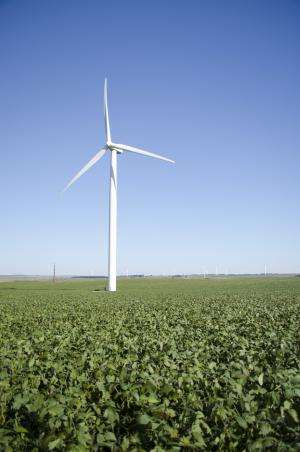Sociologists describe community support for wind farms

Harnessing wind as a powerful source of renewable energy in the Midwest means coming to terms with a landscape dotted with wind towers.
That's a reality people are willing to accept, according to assistant professor of sociology and rural studies Jeffrey Jacquet. He and graduate student Josh Fergen have conducted research in South Dakota and Minnesota to gauge attitudes about wind farms and their impact on the community and the environment.
The researchers found "an overwhelming culture of support for wind energy development" stemming, not from concern over the environment, but from the belief that the region will benefit economically from wind farms, according to Jacquet.
South Dakota has 10 utility-scale wind farms with 474 turbines, according to Brian Rounds, staff analyst at the South Dakota Public Utilities Commission. In 2013, wind generation totaled nearly 2.7 million megawatt hours. Overall, wind energy accounted for 26 percent of the electricity produced in the state, Rounds explained.
The sociologists observed what Fergen called "a culture of support for wind energy. Attitudes are dynamic, and even those who were once skeptical about the wind turbines have come to accept them," he pointed out. "The wind towers just become a part of the landscape."
"There are exceptions, of course," Jacquet noted. "But sociologists are more concerned with aggregate. We are looking at the larger picture of how wind energy impacts these rural communities."
Expectations vs. reality

Under Jacquet's tutelage, Fergen examined community attitudes toward two wind farms in central South Dakota—one built as planned and the other curtailed at less than 1 percent of its anticipated size.
The Highmore Wind Energy Center in Hyde County was the first successful utility-scale wind farm in the state, according to Fergen. The 27 turbines, capable of producing more than 40 megawatts of energy, began operating in 2003.
British Petroleum began construction of the Titan Wind Project in Hand County near Miller in 2009. The company planned to build more than 2,000 turbines that would produce 5,000 megawatts of power, making it "one of the largest wind farms in North America," Fergen explained. However, after building only 10 towers, the company decided to sell its stake in wind energy to focus on natural gas.
He surveyed 109 Hyde County residents, accounting for nearly 24 percent of the county's population, and 130 Hand County residents, more than 28 percent of that population.
Fergen hypothesized that Hyde County respondents would have more positive attitudes than those in Hand County;however, truncating the size of the Hand County project did not affect the residents' attitudes toward wind energy, Fergen explained. "County division made no difference whatsoever."
"It was kind of shocking," added Fergen, given the emphasis on economic development and tax revenues that the turbines generate for the counties.
Increased tax base
For another project, Jacquet and Fergen interviewed residents of Jerauld County in central South Dakota. Fergen described the prevailing attitude as "any rural investment is a good investment."
One respondent said, "When you talk about a multimillion dollar project, people get excited," Fergen recalled. The increased tax base has been crucial to small communities, with respondents pointing out how the revenue helped school districts.
A 2013 South Dakota law mandates that 50 percent of wind money goes to school districts where the turbines are located, 35 percent to counties and 15 percent to townships. According to property tax specialist Todd Bailey of the South Dakota Department of Revenue, wind energy payments will generate nearly $2.54 million in 2014. That means nearly $1.27 million going directly to schools.
Hunter Roberts, energy policy director at the South Dakota Governor's Office of Economic Development said that these additional tax revenues have had a profound influence on rural counties and small school districts, in particular.
Provided by South Dakota State University



















